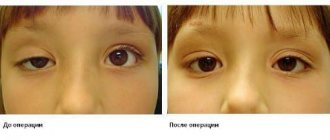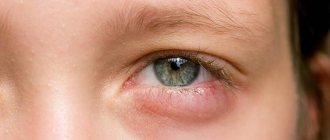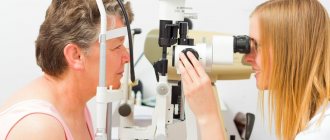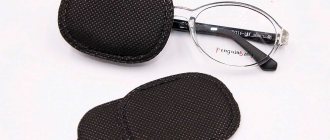Strabismus is a common visual pathology. It can be observed in both children and adults. The problem can be either congenital or acquired. Treatment of such a pathology is a complex and lengthy process. Therapy may take several years. In this case, it is important for the patient to adhere to all the recommendations of the ophthalmologist. Moreover, treatment procedures must be performed not only within the hospital, but also at home. They include visual gymnastics, exercises on ophthalmic simulators and nutrition correction. Let's talk about this in more detail.
What is strabismus?
Strabismus is the deviation of one or both eyes from the central axis. With this diagnosis, when looking straight, the eyes do not look symmetrical, which leads to impaired binocular vision.
Normally, each eye perceives the image centrally, i.e. light rays fall on the central part of the eye, the brain processes them and forms one complete image. With strabismus, this does not happen, since the brain and nervous system protect the person from double vision, and amblyopia develops - a gradual, stable decrease in vision, in which one eye is turned off from the visual process.
Causes
Strabismus can be congenital or acquired, and its causes are varied:
- anomalies in the structure of the visual analyzer;
- eye injuries;
- the presence of myopia, farsightedness or high degree of astigmatism;
- paralysis and paresis;
- developmental abnormalities of the extraocular muscles;
- diseases of the central nervous system;
- somatic diseases;
- some infectious diseases;
- frequent stress;
- mental trauma;
- a sharp decrease in vision in one eye.
Reference. Congenital strabismus can result from genetic disorders (Down syndrome), a hereditary factor (the presence of strabismus in close relatives), maternal use of alcohol, drugs and certain medications during pregnancy, birth injuries, premature birth, hydrocephalus, congenital cataracts.
Classification of pathology
Strabismus is classified on several grounds.
- According to the time of occurrence, congenital (develops before 6 months of age) and acquired (usually develops during the first three years of life, but can also appear in adults) strabismus are distinguished.
- Based on stability, a distinction is made between periodic (transient) and permanent.
- According to the involvement of the eyes, there are unilateral (monolateral) and intermittent (alternating) strabismus. In the second case, both eyes squint alternately.
According to the severity, strabismus is divided into 4 types:
- hidden (heterophoria);
- compensated (detected only during an ophthalmological examination);
- subcompensated (manifests itself when control is reduced);
- decompensated (uncontrollable).
Based on external manifestations, there are 3 broad groups of strabismus, each of which includes several more varieties.
- Horizontal strabismus can be converging or divergent, depending on which direction the eyes or one of them deviate (towards the bridge of the nose and away from the bridge of the nose, respectively).
- Vertical strabismus is classified into hypertropia (the eye is displaced upward) and hypotropia (the eye is displaced downward). Separately, cyclotropia is distinguished, in which the vertical meridian is inclined towards the temple or towards the nose.
- Mixed strabismus.
According to the causes of occurrence, there are concomitant and paralytic non-conjugal strabismus.
Signs of concomitant strabismus:
- movements of the eyeballs are fully preserved;
- no diplopia;
- binocular vision is absent.
Paralytic unfriendly strabismus is divided into three more types:
- accommodative;
- partially accommodative;
- non-accommodative.
Accommodative strabismus can be eliminated using conservative methods; the other two types most often require surgical intervention.
Useful video
Causes of strabismus:
Treatment with eye drops
Cosopt drops are an ophthalmic drug, produced in the form of combined drops, used in the treatment of various eye diseases. The drops are aimed at reducing eye pressure by stopping the process of secretion.
Compound
The drug is quite complex in recipe and consists of:
- The active ingredient is dorzolamide hydrochloride – 22.26 milligrams per milliliter.
- The second active component is timolol maleate in the amount of 6.83 milligrams per 1 milliliter.
- Also, to ensure a long shelf life of the medication, a 50% solution of chloride, sodium citrate, hydroxide, as well as menite, hydroxyethylcellulose and purified water are used.
Pharmacological effects
After using the drug, it turns out that the patient has a surgical antiglaucoma effect. It can be achieved with the help of two active components, which, when used simultaneously, reduce the production of secretions to reduce eye pressure. And also, through the use of additional substances, it is possible to achieve an anti-inflammatory as well as a relaxing effect for tense eye muscles.
At home without surgery
Correction of strabismus begins with the use of various techniques that do not require surgical intervention. As a rule, treatment of strabismus takes a long time, but in the absence of positive dynamics, doctors can adjust its tactics.
Wearing glasses
Optical correction for strabismus involves the use of glasses and contact lenses.
If you have strabismus, your doctor may choose one of the following types of glasses:
- with prismatic lenses;
- with Fresnel prisms;
- with red-blue filters;
- with color stimulation (Sidorenko glasses).
Glasses do not eliminate a cosmetic defect, but help correct the angle of vision and strengthen the eye muscles. Glasses with red-blue filters are necessary so that a person can see different pictures with each eye, i.e. the eyes are stimulated alternately. Sidorenko's glasses affect the visual nerve endings with a vacuum flow or infrasound.
Hardware therapy
The second stage of strabismus treatment is the use of hardware techniques, which are highly effective.
Pleoptic technique
Pleoptic methods of treating strabismus are aimed at synchronizing the work of both eyes, i.e. restoration of binocular vision. In this case, the healthy eye is temporarily “switched off” from work, due to which the squinting eye takes on the entire load and becomes the dominant one.
To do this, use plastic occluders that are attached to one of the glasses lenses, homemade soft curtains or translucent occluders. They must be worn continuously for several weeks or months (except at night), with regular visits to an ophthalmologist to evaluate the effectiveness of the correction.
Regular wearing of occlusive dressings leads to the restoration of visual acuity in the squinting eye.
Orthoptic technique
Orthoptic treatment aims to develop the ability to integrate images from both eyes. To do this, the fields of view are first divided, i.e. They allow each eye to see its own part of the image using special devices, after which the brain combines them.
The orthoptic technique is used after spectacle correction and pleoptic treatment and only for children over 4 years of age. Also part of orthoptics are electrical stimulation of the extraocular muscles and special exercises.
Exercises
The next stage of strabismus treatment is performing special exercises. Their implementation does not require special skills, abilities and equipment, does not take much time and leads to good results. Exercises are especially effective in childhood and in the early stages of strabismus development.
Rotation
Rotation of the eyeballs in different directions is indicated for any type of strabismus, at any degree and for people of different ages. It helps strengthen the oculomotor muscles, so it should be performed daily, preferably as a last resort.
Using a pencil
An exercise using a pencil or other small elongated object is effective for strabismus, which occurs in adults only during times of excessive tension or relaxation.
You need to take the pencil and extend your hand forward at eye level. It is necessary to concentrate on the tip of the pencil with both eyes at the same time and achieve synchronization of the image. If at first this turns out poorly, you first need to fix the gaze of the squinting eye, and then connect the healthy one.
Over time, when the concentration of gaze is achieved the first time without effort, the pencil is placed closer. You can then try to follow the pencil by moving it back and forth, up and down, and left and right.
Drawing in the air
Drawing with your eyes in the air is recommended for divergent strabismus.
The main rule when performing the exercise is an even distribution of movements in different directions. That is, it is better to draw trees, symmetrical letters (A, D, N) and objects (butterfly, flower, infinity sign). Drawing in the air should be spent at least 5 minutes a day, gradually increasing the speed of movements.
Performing eye massage for strabismus
To overcome this unwanted pathological process, eye massage is performed as an additional treatment measure. There are a large number of videos on the Internet that show certain movements to bring vision back to normal. It is important to perform them consistently and smoothly, avoiding strong pressure on the eyeballs. A competent approach to performing massage actions will help ensure that vision returns to normal, and the squinting eye can recover faster. If you are afraid to do a massage yourself, you can call a specialist at home or visit his office.
Is it possible to get rid of pathology in adolescents and adults?
In adults, strabismus is often associated with other diseases (cataracts, retinal detachment, tumors), and also occurs as a result of injuries and paralysis. When strabismus is detected, the doctor must identify its cause, after which the elimination of the root cause begins.
Expert opinion
Nosova Yulia Vladimirovna
Ophthalmologist of the highest category. Candidate of Medical Sciences.
Glasses or contact lenses are usually prescribed to restore vision lost as a result of strabismus. If they do not help restore normal visual acuity, laser correction is indicated.
If strabismus develops against the background of another ophthalmological disease (for example, cataracts), in most cases surgical intervention is indicated.
conclusions
- Eliminating strabismus is a long and painstaking job. To achieve a positive result, the patient must undergo not only outpatient treatment, but also adhere to home therapeutic techniques. All of them must be agreed upon with the attending physician. In some cases, surgery to correct strabismus is inevitable.
- Home therapy includes visual exercises. There are sets of exercises for children and adults.
- When treating strabismus, you can use computer programs such as Blade, Tsvetik-seven-flowered or Lapwing.
- During therapy, it is important to adhere to proper nutrition and eat foods that are good for vision - lingonberries, carrots, dark chocolate.
- At home, you can also use the Synoptophore apparatus. It can be used not only for therapeutic, but also for diagnostic purposes.
Prevention
The prevention of strabismus includes simple precautions that must be followed at any age.
It is necessary to limit yourself from injuries, including traumatic sports. If you experience discomfort, decreased vision, or for prevention, you should visit an ophthalmologist. Self-medication is contraindicated for any symptoms.
It is also advisable to eat properly so that your diet includes fresh vegetables, fruits and berries. Fatty, fried, smoked and spicy foods should not be consumed, as should coffee, sweets and alcoholic drinks.
Regular walks in the fresh air and moderate physical activity are beneficial for eye health. In addition, it is recommended to avoid direct exposure to sunlight on the eyes - wear sunglasses, ensure good lighting of the workplace and distribute the load in doses, avoiding prolonged viewing of TV, reading in the dark and long periods of working at the computer.
Symptoms
The symptoms of the disease are pronounced and depend on the type of strabismus.
Paralytic strabismus:
- Weakening of the visual muscle of the left or right organ of vision due to which it begins to squint in the opposite direction (left and right, respectively).
- In this case, as a rule, the healthy eye, in which no visual disturbances were noticed, is distorted, since the eye muscles in the affected eye are atrophied due to which it cannot focus, in this case the healthy eye takes on all the work, performing the function both organs and due to overstrain, a healthy organ weakens, and its muscles begin to atrophy.
Gymnastics for children
Exercises for strabismus are carried out for children in a playful way. Toys and pictures are used so that the child does not lose interest in the activity.
- Hang the ball so that it is at the level of the face of the child sitting on the side. Illuminate the ball with a lamp. Invite the baby to focus his gaze on the ball, closing his good eye.
- Invite your child to throw the ball into a box or basket. The container needs to be moved to the sides, raised up or down.
- Eye convergence exercise for children. Invite the child to stand with his back to the mirror. Close your healthy eye and turn towards the squinting eye until the reflection is clearly visible.
- Paste a bright picture on the window glass. Invite the child to look alternately at the picture and at the street landscape.
- Make a circle out of plywood or thick cardboard, cut holes of different shapes and diameters in it. Give the child a thick rope and offer to thread it through the holes to make a snake.
- Take two large sheets of paper, draw or stick pictures so that they are similar, but there are differences. Invite your child to look at the pictures one by one, looking for differences.
After play sessions, you need to do exercises to improve eye mobility - with strabismus, children develop muscle spasm, which prevents the eyeball from taking the correct position.
Practice children's eye gymnastics using the following video. Do gymnastics with us every day, to do this, save the article in your bookmarks.










